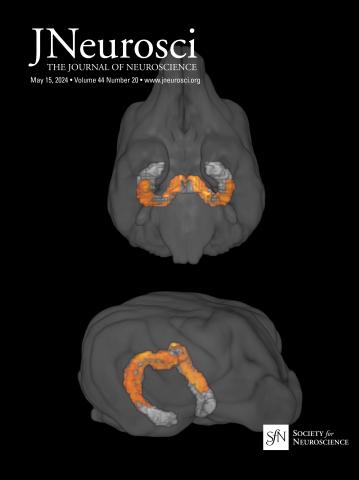The Role of Neprilysin and Insulin-Degrading Enzyme in the Etiology of Sporadic Alzheimer's Disease.
IF 4.4
2区 医学
Q1 NEUROSCIENCES
引用次数: 0
Abstract
An age-dependent decline in the amyloid-β (Aβ)-degrading enzyme neprilysin (NEP) has been implicated in the pathogenesis of sporadic Alzheimer's disease (AD). Recently identified risk alleles in the NEP-coding gene further support its role in AD etiology. However, evidence for the impact of NEP on the pathophysiological progression of Aβ plaque formation, particularly in comparison to another Aβ-degrading enzyme, insulin-degrading enzyme (IDE), is still lacking. Furthermore, the functional impact of the NEP mutation, M8V, caused by the AD risk allele in the NEP gene, remains unexplored. Here we found that NEP deficiency in App NL-F mice accelerates Aβ plaque formation more prominently than IDE deficiency in both male and female mice. Additionally, NEP/IDE double knockout further exacerbated the plaque deposition of App NL-F mice, demonstrating a synergistic effect between the two enzymes. We also revealed that the M8V mutation in NEP reduced extracellular Aβ degradation in SH-SY5Y neuroblastoma cells, not by impairing catalytic activity but by increasing phosphorylation at an intracellular serine residue. This alteration in phosphorylation decreases NEP localization on the cell surface and extracellular vesicles, thereby limiting extracellular Aβ degradation. These observations point to the role of aging-associated neprilysin decline in sporadic AD pathogenesis and endorse the strategy of upregulating neprilysin activity to treat preclinical AD.Significance Statement Neprilysin (NEP) is a key amyloid-β (Aβ)-degrading enzyme in the brain, but its role in the pathophysiological progression of Aβ plaque formation remains controversial, particularly in comparison to another Aβ-degrading enzyme, insulin-degrading enzyme (IDE). Here, we show that NEP deficiency in App NL-F mice accelerates Aβ plaque formation more prominently than IDE deficiency. This effect is further exacerbated in NEP/IDE double knockout mice, demonstrating a synergistic relationship between the two enzymes. Moreover, the AD-associated NEP M8V mutation reduces extracellular Aβ degradation in neuroblastoma cells. These observations point to the role of aging-associated neprilysin decline in SAD pathogenesis and endorse the strategy of upregulating neprilysin activity to treat preclinical AD.Neprilysin和胰岛素降解酶在散发性阿尔茨海默病病因学中的作用。
淀粉样蛋白β (Aβ)降解酶neprilysin (NEP)的年龄依赖性下降与散发性阿尔茨海默病(AD)的发病机制有关。最近在nep编码基因中发现的风险等位基因进一步支持其在AD病因学中的作用。然而,关于NEP对Aβ斑块形成病理生理过程影响的证据,特别是与另一种Aβ降解酶胰岛素降解酶(IDE)相比,仍然缺乏证据。此外,由NEP基因中的AD风险等位基因引起的NEP突变M8V对功能的影响仍未得到研究。我们发现App NL-F小鼠中NEP缺乏比IDE缺乏更明显地加速了Aβ斑块的形成。此外,NEP/IDE双敲除进一步加剧了App NL-F小鼠的斑块沉积,表明两种酶之间存在协同作用。我们还发现NEP中的M8V突变减少了SH-SY5Y神经母细胞瘤细胞外Aβ的降解,不是通过损害催化活性,而是通过增加细胞内丝氨酸残基的磷酸化。这种磷酸化的改变减少了NEP在细胞表面和细胞外囊泡上的定位,从而限制了细胞外Aβ的降解。这些观察结果表明,年龄相关的neprilysin下降在散发性AD发病机制中的作用,并支持上调neprilysin活性来治疗临床前AD的策略。Neprilysin (NEP)是大脑中关键的淀粉样蛋白-β (a β)降解酶,但其在a β斑块形成的病理生理过程中的作用仍然存在争议,特别是与另一种a β降解酶胰岛素降解酶(IDE)相比。在这里,我们发现App NL-F小鼠的NEP缺乏比IDE缺乏更明显地加速了Aβ斑块的形成。在NEP/IDE双敲除小鼠中,这种作用进一步加剧,证明了两种酶之间的协同关系。此外,ad相关的NEP M8V突变减少了神经母细胞瘤细胞外Aβ的降解。这些观察结果表明,衰老相关的neprilysin下降在SAD发病机制中的作用,并支持上调neprilysin活性治疗临床前AD的策略。
本文章由计算机程序翻译,如有差异,请以英文原文为准。
求助全文
约1分钟内获得全文
求助全文
来源期刊

Journal of Neuroscience
医学-神经科学
CiteScore
9.30
自引率
3.80%
发文量
1164
审稿时长
12 months
期刊介绍:
JNeurosci (ISSN 0270-6474) is an official journal of the Society for Neuroscience. It is published weekly by the Society, fifty weeks a year, one volume a year. JNeurosci publishes papers on a broad range of topics of general interest to those working on the nervous system. Authors now have an Open Choice option for their published articles
 求助内容:
求助内容: 应助结果提醒方式:
应助结果提醒方式:


